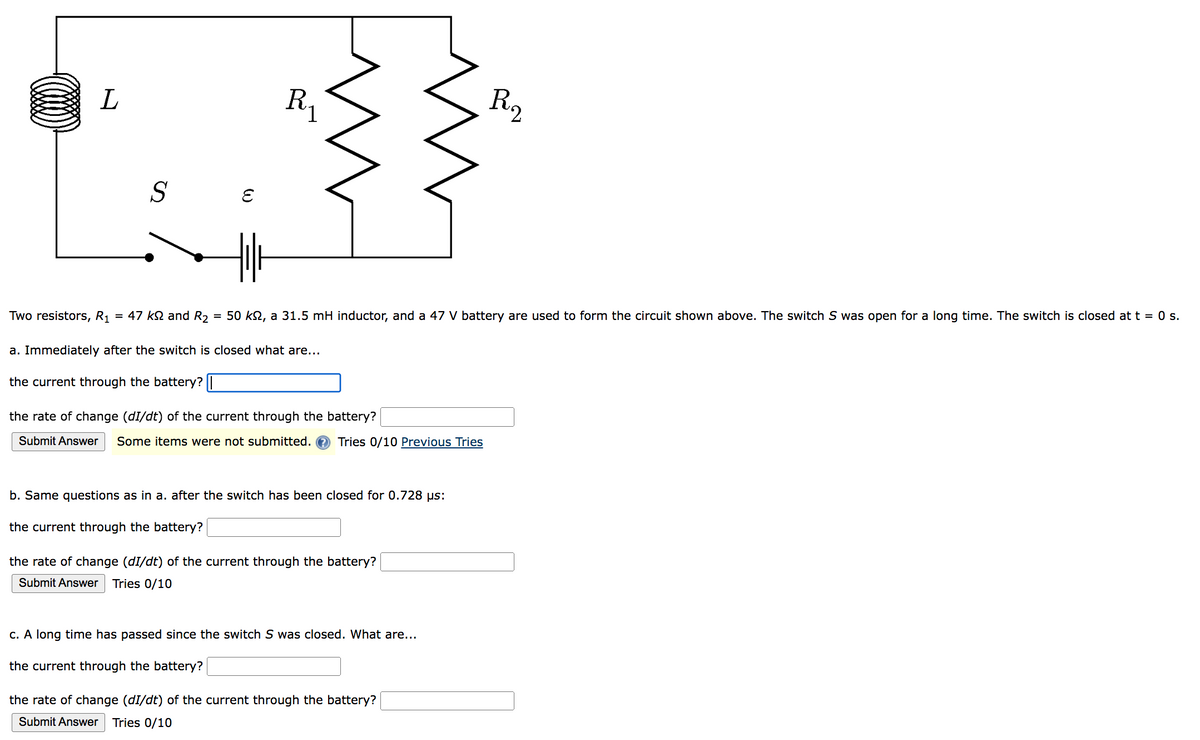Two resistors, R₁ = 47 k and R₂ = 50 k2, a 31.5 mH inductor, and a 47 V battery are used to form the circuit shown above. The switch S was open for a long time. The switch is closed at t = 0 s. a. Immediately after the switch is closed what are... the current through the battery? the rate of change (dI/dt) of the current through the battery? Submit Answer Some items were not submitted. Tries 0/10 Previous Tries b. Same questions as in a. after the switch has been closed for 0.728 us: the current through the battery? the rate of change (dI/dt) of the current through the battery? Submit Answer Tries 0/10 c. A long time has passed since the switch S was closed. What are... the current through the battery? the rate of change (dI/dt) of the current through the battery? Submit Answer Tries 0/10
Two resistors, R₁ = 47 k and R₂ = 50 k2, a 31.5 mH inductor, and a 47 V battery are used to form the circuit shown above. The switch S was open for a long time. The switch is closed at t = 0 s. a. Immediately after the switch is closed what are... the current through the battery? the rate of change (dI/dt) of the current through the battery? Submit Answer Some items were not submitted. Tries 0/10 Previous Tries b. Same questions as in a. after the switch has been closed for 0.728 us: the current through the battery? the rate of change (dI/dt) of the current through the battery? Submit Answer Tries 0/10 c. A long time has passed since the switch S was closed. What are... the current through the battery? the rate of change (dI/dt) of the current through the battery? Submit Answer Tries 0/10
Principles of Physics: A Calculus-Based Text
5th Edition
ISBN:9781133104261
Author:Raymond A. Serway, John W. Jewett
Publisher:Raymond A. Serway, John W. Jewett
Chapter23: Faraday’s Law And Inductance
Section: Chapter Questions
Problem 47P
Related questions
Question

Transcribed Image Text:L
S
Two resistors, R₁ = 47 ks and R₂
=
W
R₁
m
a. Immediately after the switch is closed what are...
the current through the battery? |
50 kn, a 31.5 mH inductor, and a 47 V battery are used to form the circuit shown above. The switch S was open for a long time. The switch is closed at t = 0 s.
the rate of change (dI/dt) of the current through the battery?
Submit Answer Some items were not submitted. Tries 0/10 Previous Tries
b. Same questions as in a. after the switch has been closed for 0.728 µs:
the current through the battery?
the rate of change (dI/dt) of the current through the battery?
Submit Answer Tries 0/10
R₂
c. A long time has passed since the switch S was closed. What are...
the current through the battery?
the rate of change (dI/dt) of the current through the battery?
Submit Answer Tries 0/10
Expert Solution
This question has been solved!
Explore an expertly crafted, step-by-step solution for a thorough understanding of key concepts.
This is a popular solution!
Trending now
This is a popular solution!
Step by step
Solved in 5 steps with 4 images

Knowledge Booster
Learn more about
Need a deep-dive on the concept behind this application? Look no further. Learn more about this topic, physics and related others by exploring similar questions and additional content below.Recommended textbooks for you

Principles of Physics: A Calculus-Based Text
Physics
ISBN:
9781133104261
Author:
Raymond A. Serway, John W. Jewett
Publisher:
Cengage Learning


Physics for Scientists and Engineers with Modern …
Physics
ISBN:
9781337553292
Author:
Raymond A. Serway, John W. Jewett
Publisher:
Cengage Learning

Principles of Physics: A Calculus-Based Text
Physics
ISBN:
9781133104261
Author:
Raymond A. Serway, John W. Jewett
Publisher:
Cengage Learning


Physics for Scientists and Engineers with Modern …
Physics
ISBN:
9781337553292
Author:
Raymond A. Serway, John W. Jewett
Publisher:
Cengage Learning

Physics for Scientists and Engineers, Technology …
Physics
ISBN:
9781305116399
Author:
Raymond A. Serway, John W. Jewett
Publisher:
Cengage Learning

Physics for Scientists and Engineers: Foundations…
Physics
ISBN:
9781133939146
Author:
Katz, Debora M.
Publisher:
Cengage Learning